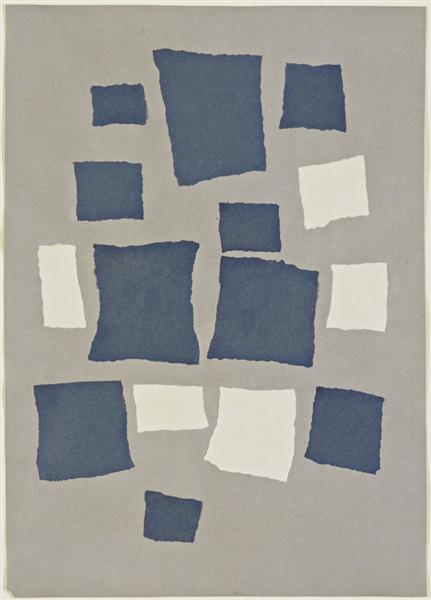Kurt Schwitters, who is now considered a Dadaist movement’s pioneer and a significant figure in 20th century art for his groundbreaking approach to collaging, had a profound impact on both form and function of art. The most awe-inspiring of his creations is “Collage with Squares Arranged According to the Laws of Chance,” which embodies the artist’s innovative and philosophical principles. In this piece we will talk about the life and art of Kurt Schwitters, the mysterious painting discussed and some intriguing details surrounding it.
Who was Kurt Schwitters?

Kurt Schwitters, who was born in Hanover, Germany, in 1887, was a visionary artist with world-renowned creative accomplishments in the realm of modern art. From his childhood Schwitters demonstrated creative inclinations striving to explore different styles and unique methods. However, it was his adventure into the Merz technique that would eventually catapult him to become the luminaria of art.
His Career
During his artistic career, Schwitters displayed a remarkable resilience and ingenuity. Although this was against many odds and faced some opposition, he was always himself and would not give up on trying his best for the creative ends. As with Merz pieces, a collage-like composition and the use of found materials characterized geometric abstract paintings. They undermined common aesthetic perceptions. By the prodigious amount of work he accomplished and by being steadfast in his diligence to his art, Schwitters became a leading figure in Dadaism and Constructivism, a movement that is still affecting newer generations of artists.
What is Happening in “Collage with Squares Arranged According to the Laws of Chance”?

| Artist | Kurt Schwitters |
| Date Created | 1917 |
| Medium | Collage |
| Genre | Dadaism |
| Period | Early 20th century |
| Dimensions | Approximately 32 x 27 centimeters |
| Series / Versions | N/A |
| Where is it housed? | Private Collection / Various Art Institutions Worldwide |
A prime example of Kurt Schwitters’ revolutionary collage technique is “Collage with Squares Arranged According to the Laws of Chance,” created in 1917. This relatively small artwork, measuring around 32 by 27 centimeters, features a captivating arrangement of colored squares laid out on a rectangular grid. While the composition initially appears abstract, closer inspection reveals a subtle order beneath the surface.
Schwitters employed a unique approach in this work, relying on chance to determine the placement of each square. This technique reflects his fascination with the unpredictable nature of existence. Interestingly, despite the seemingly random layout, the collage maintains a sense of unity and symmetry. This interplay between order and disorder, a recurring theme in Schwitters’ work, hints at a hidden system governing the seemingly chaotic arrangement.
Interesting Facts about the Artwork
Chance and Order: Schwitters’ use of chance in arranging the squares challenges the traditional notion of artistic control, inviting viewers to contemplate the role of randomness in the creative process.
Influence on Contemporary Art: “Collage with Squares Arranged According to the Laws of Chance” foreshadowed the emergence of abstract expressionism and conceptual art, influencing generations of artists to explore new avenues of artistic expression.
Legacy of Merz: The concept of “Merz” permeates Schwitters’ body of work, representing his quest to find coherence in the chaos of modern life—a theme that continues to resonate in contemporary art.
Fragmentation and Unity: Through the juxtaposition of disparate elements, Schwitters sought to reconcile fragmentation with unity, offering a profound commentary on the human condition and the quest for meaning amidst chaos.
Frequently Asked Questions
What was Kurt Schwitters inspired by?
Schwitters was drawn to the newly formed Dada school shortly after World War I. Dada was a nihilistic literary and creative movement that aimed to destroy preexisting aesthetic norms.
Why was Kurt Schwitters important?
In 1917, Schwitters worked as a draftsman in the armed forces before experimenting with Cubist and Expressionist approaches. His earliest collages were created in 1918, and he coined the term “Merz” in 1919 to refer to all of his artistic endeavors, including collage and constructions, poetry, and other media.
Conclusion
Known as one of art history’s most provocative figures, Kurt Schwitters’ groundbreaking work, “The Collage with Squares Arranged According to the Laws of Chance,” exemplifies his lasting contribution to the development of contemporary art. Through his radical collage technique and embrace of chance, Schwitters challenged established artistic conventions and pushed the boundaries of creative expression. Consequently, his legacy remains an inexhaustible source of inspiration for both artists and art lovers alike.













